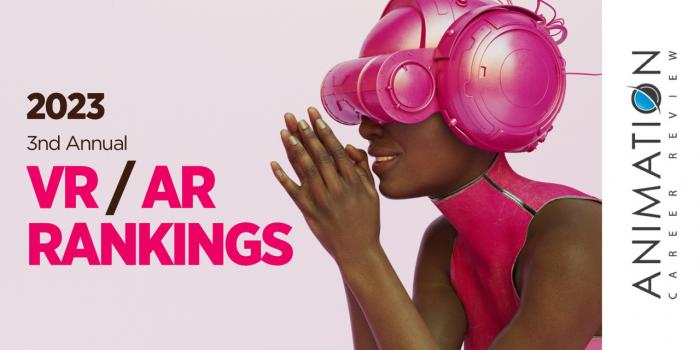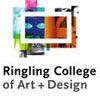
Did you know? Savannah College of Art and Design offers AR/VR resources, a green screen, a motion media lab, more than 800 computers networked to reduce render times, and immersive reality classrooms. Learn more.

| Ranking | School | State |
|---|---|---|
| 1 | Georgia Institute of Technology | Georgia |
| 2 | Savannah College of Art and Design | Georgia |
| 3 | University of Central Florida | Florida |
| 4 | University of North Carolina at Chapel Hill | North Carolina |
| 5 | University of Florida | Florida |
| 6 | Duke University | North Carolina |
| 7 | Full Sail University | Florida |
| 8 | North Carolina State University | North Carolina |
| 9 | Ringling College of Art + Design | Florida |
| 10 | University of South Carolina-Aiken | South Carolina |
Our 2023 rankings -our third annual- of the Top 10 AR/VR School Programs in the South. For an explanation of ranking criteria, click here.

Georgia Institute of Technology (Georgia Tech) provides a number of programs for students who would like to study AR/VR. Options are housed across several colleges and schools including Ivan College of Liberal Arts; the College of Computing, which houses the Schools of Computer Science, Computational Science & Engineering, and Interactive Computing; and the School of Literature, Media, and Communication.
Specific degree programs for students interested in AR/VR include the BS in Computational Media, BS, MS and PhD degrees in Computer Science, and Minors in Computing & Devices, Computing & Intelligence, and Computing & People. The Computer Science programs provide opportunities for students to select from research areas such Virtual & Augmented Environments, Ubicomp & Wearable Computing, AI and Machine Learning, Robotics and Perception, and Geometry, Graphics, and Animation.
With approximately 300 students, the Computational Media BS is one of Georgia Tech’s fastest growing programs and a top choice for students interested in AR/VR. Students in this program have opportunities to focus in areas such as Interactive Design, Games, and Music Technology - Intelligence. Course examples include Constructing the Moving Image; Science, Technology and Performance; Video Game Design and Programming; Interaction Design; Computer Animation; and Experimental Media.
Students in all Georgia Tech programs have access to the school’s GVU Center, which supports AR/VR, AI, Robotics, HCI, Wearable Computing, and other research. Within the GVU Center is the Augmented Environments Lab, which focuses on building interactive computing environments that directly augment the users senses with computer-generated material.
Also located in the GVU Center is the Prototyping eNarrative Lab. Also known as PeN Lab, the Lab focuses on emerging platforms such as AR/VR, experimental television, and the intersection of storytelling with simulation and game design.
Examples of Lab projects include The Lights of St. Etienne: An AR/MR (Mixed-Reality) Experience in the Cathedral in Metz, France, Bringing Interactivity to Static Data Visualizations through Augmented Reality, Escape Room VR, WebXR: Experiences in AR and VR for the Web, Pipping: Exploring Passive Haptics in Virtual Reality, and Interaction Techniques for Children's AR Education, Invisible Cities: Multi-User AR Public Monuments.
Georgia Tech graduates are prepared to pursue careers in Virtual and Augmented Reality, Special Effects Creation, Interactive Game Design and Simulation, Robotics, and Animation, among others. Graduates work in leadership positions in areas such as consulting, engineering, financial services, healthcare, law, manufacturing, retail, transportation, and humanitarian logistics.
Georgia Tech alumni have been hired by companies such as Microsoft, Boeing, Apple, Disney, Tesla, Google, IBM, Delta Airlines, Intel, and Cisco Systems.
Georgia Institute of Technology was founded on October 13, 1885. When the school opened in 1888, it welcomed 129 students enrolled in one degree program—the Mechanical Engineering BS. Today, Georgia Tech serves approximately 45,300 students enrolled in more than 180 degree programs and minors across six distinct colleges and 28 schools. The school also has three campuses including the main campus in Atlanta, Georgia; Georgia Tech-Lorraine in Metz, France; and Georgia Tech-Shenzhen in China.
Georgia Institute of Technology is accredited by the Southern Association of Colleges and Schools Commission on Colleges (SACSCOC).

Savannah College of Art and Design (SCAD) is home to the SCAD Digital Media Center. Within the Center are the School of Digital Media and the School of Entertainment Arts. The School of Digital Media houses an Immersive Reality BFA that launched in 2018. This 180 credit hour program allows students to explore related fields such as User Experience (UX) Design, Visual Effects, Film and Television, and Interactive Design. Students may add an additional major or minor in any of these areas.
Program features include collaboration with students and faculty across disciplines; access to panels and presentations by gaming giants such as EA Sports, Ubisoft, and Cartoon Network Games; and study abroad opportunities at SCAD Lacoste, France. Immersive Reality students also have access to Montgomery Hall, which houses AR/VR resources, more than 800 computers networked to decrease render times, a green screen, and a motion media lab.
In The Shed at SCAD, immersive reality labs and classrooms house the latest technology for creating innovative visual experiences.
To begin the program, students will take Foundation Studies courses such as Design I: Elements and Organization, Design II: 3D Form and Space, Design III: Time, Creative Thinking Strategies, and Storyboarding Essentials. Mathematics or Computer Science, Digital Communication, and Speaking of Ideas are just a few required General Education courses.
In the Immersive Reality BFA major, students will take courses such as Augmented Reality Lab, Virtual Reality for Motion Media, Immersive Revolution: Augmented to Virtual Reality, Visual Storytelling: Virtual Reality to Interactive, Immersive Innovation Lab, Visual Effects for Immersive Environments, Integration of Immersive Realities, Immersive Innovation Lab, Advanced Application Scripting, and Game Engine Applications for Immersive Computing. Fifteen credit hours of additional electives allow students to enhance the degree by exploring related or other areas.
All students have access to the expanded Savannah Film Studios, which is the largest and most comprehensive university film studio complex in the nation. The 10.9-acre facility includes a next-generation XR stage for virtual productions, new soundstages, and a Hollywood-caliber film backlot.
Launched in 2014, the original Savannah Film Studios building consisted of a 22,000-square-foot facility with three soundstages, green rooms, lighting grids, postproduction suites, a multi-purpose recording booth for ADR and Foley recordings, screening rooms, and production offices for SCAD’s film and television program.
Graduates of the Immersive Reality BFA Program at SCAD are prepared for graduate study and/or careers such as AR/VR Developer, AR Designer, Virtual Production Technical Director, VR Content Producer, Mixed Reality Artist, Game Designer, Realtime Artist, Technical Artist, and Environmental Artist.
Approximately 99% of Savannah College of Art and Design graduates are employed, enrolled in a graduate program, or both within 10 months of graduation. Immersive Reality alumni have been hired by companies and studios such as Microsoft, Adobe, Epic Games, Google, Autodesk, Blizzard Entertainment, Facebook, ZeniMax Online Studios, and Magic Leap.
With more than 100 degree programs and over 75 minors and certificate programs, Savannah College of Art and Design has more degree programs and specializations than any other art and design college in the U.S. Founded in 1978, SCAD opened in the renovated Savannah Volunteer Guards Armory in September 1979. The school began with just one classroom, an administration building, and 71 students. Today, SCAD serves more than 15,000 students across campuses in Atlanta and Savannah, Georgia, and Lacoste, France.
Savannah College of Art and Design is accredited by the Southern Association of Colleges and Schools Commission on Colleges (SACSCOC), the Council for Interior Design Accreditation (CIDA), and the National Architecture Accrediting Board (NAAB).

The College of Engineering and Computer Science at University of Central Florida (UCF) houses the Department of Computer Science, which has several pathways to study AR/VR. Degree options include the Computer Science (CS) BS, an Accelerated BS/MS in CS, and MS and PhD degrees in Modeling and Simulation. For students seeking a shorter program, the Department has a Mixed Reality Engineering Graduate Certificate. This program requires nine credit hours of coursework including Virtual Reality Engineering, Augmented Reality Engineering, and the Mixed Reality Project. The culminating project consists of the development of a mixed reality system or software application.
The Department of Computer Science at University of Central Florida also houses several labs that allow students in the Certificate and Degree programs to collaborate, create AR/VR systems and applications, and conduct research related to AR/VR.
The Synthetic Reality Lab known as SREAL is part of several larger UCF entities, most notably the Institute for Simulation & Training (IST), which houses it. SREAL (pronounced Surreal) is a center for researchers, software developers, artists (modelers/animators), interactors (digital puppeteers), PhD students, and affiliated faculty members. With 7,000 square feet of experimental and office space, SREAL houses areas for the development of AR/VR, mixed reality experiences, the delivery of interactive training using digital avatar technology, human surrogate and robotics research, and developing cultural heritage and STEM experiences.
The Interactive Systems and User Experience Lab focuses on the development of innovative applications, techniques, and tools that enhance the overall experience between humans and machines.
The Computer Science BS at UCF consists of courses such as Algorithms for Machine Learning, Robot Vision, Game Programming, Software Engineering, Computer Graphics, Advanced AI, Computer Architecture, and AI for Game Programming.
Graduates of the Computer BS Program are prepared for careers in AR/VR, Computer Architecture, Computer Gaming, Computer Vision, Evolutionary Computing, Media Convergence, Robotics, and many others.
The Computer Science MS at UCF allows students to specialize in a research area. This includes options such as VR, Mixed and Virtual Reality Mobile Computing, Modeling and Simulation, Machine Learning, Human-Computer Interaction (HCI), and Artificial Intelligence (AI). Pairing (combining two research areas) is also an option. In addition to their chosen specialization, CS MS students will study programming systems and languages, computer science theory, and computer architecture.
Graduates of the Computer Science MS Program at University of Central Florida are prepared to pursue careers in AR/VR, Software Development, Computer Science, Aerospace, Computer Systems, Software Engineering, Cyber/Information Security, and Defense. UCF CS alumni are routinely hired by major companies such as NASA, Lockheed Martin, IBM, Google, Apple, Oracle, Intel, Amazon, Siemens, Cisco, YouTube, and Accenture.
University of Central Florida opened in 1968 as Florida Technological University. On the first day of classes, the school had less than 2,000 students. Today, UCF serves around 70,400 students, making it the largest university by enrollment in the state of Florida, and one of the nation’s largest universities. The school provides 240 bachelor’s degrees, 214 master’s degrees, and 81 doctorate degrees across 13 colleges. University of Central Florida is accredited by the Southern Association of Colleges and Schools Commission on Colleges (SACSCOC).

University of North Carolina at Chapel Hill (UNC-Chapel Hill) the College of Arts and Sciences, home to the Department of Computer Science (CS). Established in 1964, the CS Department was one of the first independent computer science departments in the U.S. Within the Department are several options for students who would like to study AR/VR.
Pathways include BS and MS degrees in Computer Science with a Computer Graphics or Human-Computer Interaction (HCI) Research Area. Computer Graphics sub-areas include Animation & Simulation, Virtual Environments, and Visualization. HCI offers a Virtual Environments subarea. A PhD in Computer Science is also available.
Course examples across programs include 2D Computer Graphics, Connecting Language to Vision and Robotics, Digital Culture, Digital Logic and Computer Design, Human Robot Interaction, Machine Learning, Models of Languages & Computation, Scientific Programming, and Software Engineering Laboratory.
In addition to a variety of AR/VR related courses, SCS students have access to a number of organizations and labs to support their goals. The Carolina Augmented and Virtual Reality Club (CARVR) provides the opportunity to work on extended reality (XR) projects with real clients. Students may also participate in the UNC Augmented and Virtual Reality Interest Group (UNC AR/VR), which consists of more than 250 people from across campus. The Group focuses on training, research, learning, and more through the use of immersive technologies. UNC AR/VR plans to launch two additional groups soon (a Faculty Group and Student Group), that focus on AR/VR.
Students interested in AR/VR at UNC-Chapel Hill have access to the Graphics, Imaging, and Robotics Lab and the Graphics and 3D Vision Laboratory. The Graphics, Imaging, and Robotics Lab is a 3,500 sq. ft. space located in J. Carlyle Sitterson Hall. Most of the Lab is dedicated to work in effective virtual environments. The remaining area, which houses a variety of robots, focuses on robotics research.
Housed in the Frederick P. Brooks Jr. Computer Science Building and Sitterson Hall, the new Graphics and 3D Vision Laboratory is situated in a noise-controlled, 2,500 sq. ft. space divided into three research zones by floor-to-ceiling blackout curtains for light and sound suppression. Zones include Projective Display Research, Computer Vision and Optical Tracking Research, and Physical Simulation and Audio Synthesis Research with a focus on GPU processing. The space has 11-foot ceilings and a Unistrut mounting grid.
Across facilities and labs, projects and groups have included the Effective Virtual Environments Project; Geometric Algorithms for Modeling, Motion, and Animation Group (GAMMA) Project; and the Walkthrough Group, (simulated walkthroughs of architectural models).
UNC-Chapel Hill graduates have gone on to establish careers at some of the world’s top corporations. Examples include Microsoft, Amazon, Cisco, Capital One, SAS – Analytics Software & Solutions, Red Ventures, and Accenture.
Founded in 1789, University of North Carolina at Chapel Hill welcomed its first students in 1795, becoming the first and only public university in the U.S. to award degrees in the 18th century. Today, UNC-Chapel Hill serves more than 31,500 students enrolled in over 250 bachelor’s, master’s, and PhD programs across 14 colleges and schools. University of North Carolina at Chapel Hill is accredited by the Southern Association of Colleges and Schools Commission on Colleges (SACSCOC).

University of Florida (UF) is home to the College of the Arts. Within the College is the Digital Worlds Institute, which houses the Master’s in Digital Arts & Sciences (MiDAS). This one-year, accelerated program explores emerging technologies—specifically AR/VR—and individuals from all backgrounds are encouraged to apply.
The MiDAS Program curriculum includes Technical Skills: Game Engines and Development (i.e. Unity 3D) and Software and Hardware Integration; Design and Interactivity: Visual Design Tools/Tech, 3D for AR/VR, UI-UX, Audio, Digital Compositing, and Digital Storytelling; and Professional Skills: Project Proposals, Production Pipelines, Project Management, and Critical Thinking and Analysis.
Other MiDAS Program features include opportunities to work on real-world projects in the industry; personal attention from faculty and content area experts; a collaborative environment; and professional portfolio development. UF MiDAS Students also have access to the UF Reality Lab at the Digital Worlds Institute.
The Lab explores and promotes research and educational endeavors in AR/VR. Examples of Lab courses include Production of Immersive Environments; Movement, Media, and Machines; Digital Storytelling; and Interdisciplinary Research Seminar. Past student projects include Metrolia VR Multiplayer Mech Duel; Space Mail; SpArc: Animate Using Your Hands in Virtual Reality; ScootVR; HoloTouch; and WonderLab.
Graduates of the MiDAS Program and others have been hired at Boeing, Walt Disney, GE Digital-Meridium, Cox Media Group, the U.S. Navy, Glaxo Smith Klein, the U.S. Department of Defense, Aramark, ESPN, 22squared, Reed Exhibitions, and Spirit Airlines.
University of Florida was founded in 1858 as Gainesville Academy. When it opened, the Academy has just a few students. Today, UF serves approximately 61,110 students making it one of the top 10 largest universities in the U.S. and one of the top five largest in Florida. More than 300 programs are available at UF, across 16 colleges and schools. University of Florida is accredited by the Southern Association of Colleges and Schools Commission on Colleges (SACSCOC).

Duke University (Duke) houses the Trinity College of Arts and Sciences, home to the Department of Computational Media, Arts & Cultures and the Department of Computer Science. Within the Departments are several degree pathways, studios, and labs for students looking to learn about, develop, and experience AR/VR.
Duke University’s most popular undergraduate program is Computer Science. This is also the most popular paths for students interested in studying AR/VR. Leading to a BA, BS, MS, or PhD, the Program provides access to all of the schools labs and studios. Students may also enroll in an Interdepartmental Major (IDMs), which combines two academic disciplines in Trinity College, with seven courses from each to create a major.
Labs include the Institute for Virtual and Augmented Reality for the Digital Humanities (VARDHI), which focuses on the application of VR and AR to humanities research, outreach, and teaching; Duke Immersive Virtual Environment (DiVE) in the Pratt School of Engineering—a large-scale virtual reality facility established in 2005; the Innovation Co-Lab, which explores VR technology; TEC VR at the Technology Engagement Center/Co-Lab, where students can experience VR; and Bolt VR—a space equipped with a state-of-the-art, custom gaming PC, 4K display for remote, and the Vive immersive VR system.
Studios include the Multimedia Project Studio (MPS) at Duke, which offers resources for students and developers to begin their VR projects. In addition, the Dig@Lab within the Department of Computational Media, Arts & Cultures conducts AR/VR research and develops apps, virtual environments, and VR applications.
Graduates of the Computer Science Programs at Duke University are prepared to pursue careers in all areas of Computer Science, AR/VR, Aerospace, Entertainment, Defense, and Education, among others.
Although Duke University was established in 1924, the School of Law and Trinity College of Arts & Sciences here were established in 1904 and 1859, respectively. Duke’s other eight colleges and schools were established between 1926 and 2009. Today, the school serves 17,155 students enrolled in more than 200 programs. Duke University is accredited by the Commission on Colleges of the Southern Association of Colleges and Schools.

Full Sail University (Full Sail) joined the Orlando/Central Florida Chapter of the VR/AR Association (VRARA) in November 2021 to help advance the VR/AR community through education. The school also provides a variety of degree programs that focus on Emerging Technologies including Simulation & Visualization, Artificial Intelligence (AI), Computer Science, Game Development, IT, Mobile Development, and Cybersecurity.
Recommended degree options for students interested in AR/VR at Full Sail include the Simulation and Visualization BS and the Computer Science BS with a Concentration in Artificial Intelligence (AI). Course examples for the Simulation and Visualization Program include Virtual and Augmented Reality, Artificial Intelligence (AI), Programming I & II, Simulation and Visualization Software, Simulation Production, Computer Graphics, and Technology in the Entertainment and Media Industries.
Students in the Computer Science BS/AI will take courses such as Computer Vision, Data Visualization and Modeling, Human-AI Interaction, Machine Intelligence Systems, Software Integration, Natural Language Processing, and Artificial Intelligence Architecture.
Simulation and Visualization students will complete a project and build a portfolio through the Project and Portfolio I-VII: Simulation and Visualization courses. Students in the Computer Science BS will complete the same through Project and Portfolio I-VII: Computer Science.
Students in all programs will work on projects and portfolios in Full Sail’s AR/VR Lab and FabLab.
The AR/VR Lab houses state-of-the-art equipment such as headsets from Oculus, Magic Leap, Microsoft, and HTC, a green screen, and other tools/equipment to develop AR/VR projects.
Launched in 2016, FabLab is set up like a workshop. The space includes 3D printers, laser scanners, injection molding machines, and more. Students in the lab can work on projects, collaborate, and network.
While graduates of the Emerging Technology Programs at Full Sail University are prepared to pursue positions in all industries, many graduates have been hired by major studios and productions around the world. Examples include Industrial Light & Magic (ILM), Cirque du Soleil, Nickelodeon, Blizzard Entertainment, DreamWorks Animation, Rockstar Games, Pixar, Universal Studios, MTV, Disney, Bunim Murray Productions, Miramax, HBO Studios, and NFL Films.
Full Sail University offers graduate certificates and programs at all degree levels in the Arts, Entertainment, Media, and Technology. The school, which opened in 1979 in Dayton, Ohio, is located just 35 minutes from downtown Orlando and Universal Studios. Serving approximately 21,000 students, Full Sail is accredited by the Accrediting Commission of Career Schools and Colleges (ACCSC).

North Carolina State University (NC State) is home to the College of Design, which recently celebrated its 75th year in existence. Within the College are several labs including Experience Design (IX) and Mixed Reality (MxR). The IX Lab is a cross-disciplinary community of artists, designers, humanists, scientists, and engineers that focus on expanding worlds through AR/VR and other new and emerging technologies.
The MxR Lab consists of designers, engineers, and individuals interested in experimentation. The Lab focuses on AR/VR and MR technologies. Projects have included Axe One, Morphaces, and Pop’n’Play.
The College of Engineering at NC State is home to the Edward P. Fitts Department of Industrial and Systems Engineering, which houses an additional lab—the Virtual and Augmented Reality Lab (VR).
In the VR Lab researchers study the interaction between humans and AR/VR. Projects have included User Performance Training and Patient Motor Learning. Current projects include Scale Cognition through Advanced Learning Environments in Virtual Reality (SCALE-VR); Virtual Instructor Application using Augmented Reality for Worker Posture Training; and Investigation of Virtual Reality Guided Upper Limb Exercises.
Accessible equipment includes four-sided (C4) Cave Automatic Virtual Environment (CAVE) with full-body tracking capability, several head-mounted displays (HMDs), and a head-up display (HUD). In addition, a variety of peripheral devices that support movement tracking are available.
The College of Design at North Carolina State University has several programs for students interested in studying AR/VR. Options include BA and MA degrees in Art + Design (A + D) and a 16 credit hour A + D Minor with a customizable curriculum. All programs provide access to the schools AR/VR labs.
The interdisciplinary, studio-based A + D BA program provides the opportunity to learn about and develop creative portfolios in areas such as AR/VR, Interactive and Computational Media, Motion Graphics, Visual Effects (VFX), Graphic and Interactive Narratives, Game Design, 3D Modeling, and others. In addition, three Concentrations are available: Gaming + Interaction Design, Animation (2D + 3D), and Fibers + Soft Construction.
Students may also create a focus through required free electives totaling 12 credit hours. Elective examples include Advanced Digital Techniques, Digital Representation, and Art + Design Laboratory. Course examples for the program include Visualization, Art + Design Laboratory, Creative Technology, Digital Imaging, Advanced Digital Techniques, Digital Motion, and Animation. Studios include Creative technology, Art and Design International, and Design, Context, and Experience.
The A + D MA (M.A.D) focuses on Experimental Media Arts. Depending on the student’s academic background and experience, they may enroll in the 30-, 48- or 72-credit Track. Course examples include Sequential Imaging, Visualizing Narratives, Graduate Studio: Immersive and Experimental narratives, Digital Motion, Special Effects, Animation, Dynamic Data, Digital Modeling, and Coding for Designers. Final projects for the M.A.D. Program may explore AR/VR, VFX, Interactive and Computational Media, Graphic and Interactive Narratives, Visual Composition, and Motion Graphics, among others.
Graduates of the A + D programs at North Carolina State University work in fields such as Software Design, Multimedia, Illustration, Textile Design, Fashion Design, Art and Design Education, Photography, Filmmaking, SFX and VFX, Set Design, Exhibition Design, Museum Education, and Public Art. Some graduates have launched their own businesses and studios.
North Carolina State University employs 9,000+ faculty and staff that serve more than 36,000 students, making it the largest university in the University of North Carolina System. Established in 1887 as a land-grant institution focusing in agriculture and engineering, NC State offers more than 300 degree programs across 11 colleges, 68 departments, and The Graduate School. North Carolina State University is accredited by the Southern Association of Colleges and Schools Commission on Colleges (SACSCOC).

In 2018, Ringling College of Art + Design launched the world’s first degree program dedicated solely to Virtual Reality Development. Housed in the Virtual Reality Department and leading to a BFA, the Program helps students develop skills in designing, creating, and analyzing immersive experiences. The program also explores communication, collaboration, and professional practices.
Course examples for this 120 credit hour program Introduction to Virtual Reality, Concept Development for Virtual Worlds, Immersive Media Design I-IV, Programming for Immersive Media, Iterative Design, Visual Scripting, 3D Technical Art, 2D Design, Visual Development: UI/UX, and History of Immersive Media. Open electives allow students to develop skills in other areas. These courses may be selected within the Virtual Reality Development Department or other departments at Ringling.
In the final year of the Virtual Reality Development BFA, students will complete VR Thesis Production, VR Capstone I, and VR Capstone II worth 12 credits. Students will leave the program with a portfolio, body of work, and job application packet.
Graduates of the Virtual Reality Development Program at Ringling are prepared for careers in all industries that require AR/VR skills. Examples include entertainment, education, aerospace, engineering, architecture, healthcare, advertising, game design, eCommerce, law enforcement training, defense, aviation, corporate training, and disaster management.
Companies that have hired graduates of the Virtual Reality Development Program at Ringling include Google VR, Insomniac Games, Disney VR, Framestore, Oculus VR, Flight School, Epic Games, Rewind Studios, Magic Leap, D3 Creative Studios, Ready at Dawn, BAOBAB Studios, Sharecare, Kite & Lightning, and Hoyt Architects.
Ringling College of Art and Design is a private, not-for-profit college that serves more than 1,600 students enrolled in eleven majors leading to a BFA degree, two majors leading to a BA, and minor options in 10 areas. Founded more than 130 years ago by circus magnate John Ringling, RCAD is accredited by the National Association of Schools of Art and Design (NASAD) and the Southern Association of Colleges and Schools Commission on Colleges (SACSCOC).

The College of Sciences and Engineering at University of South Carolina-Aiken (USC Aiken) houses the Department of Mathematical Sciences. Within the Department is an Applied Computer Science Program with a Game and Simulation Option. Leading to BS, the program explores the design and development of virtual and augmented reality learning environments. Students immerse in projects that utilize programming (python, object-oriented), 3D and animation, graphics, computer organization, haptics, physics engines, educational design, physics, and psychology.
Students will also learn how to work with algorithmic design, software engineering, information security, and data structures. Courses for the program may include Computer Applications and Programming, Design and Evaluation of Games and Simulations, Physics Engine Integration, Video Games, Media and Culture, Software Engineering, Computer Graphics, Object-Oriented Programming, Mobile Application Development, Digital Storytelling, Design and Development Tools, Digital Video Effects, and System-Level Programming.
Graduates of the Applied Computer Science Program at University of South Carolina-Aiken are prepared to pursue careers in the global computer services industry, game design, entertainment, entertainment, science, medicine, health, and education. Potential job titles include AR/VR Capture Systems Engineer, XR Gameplay and Tools Engineer, Programmer, AR/VR Researcher, 3D Artist, Game Designer, Software Developer, AR/VR Maintenance and Support, Content Producer, Game Developer, and Graphics Engineer.
Established in 1961, University of South Carolina-Aiken (USC Aiken) is the fourth campus founded in the eight campus University of South Carolina System. USC Aiken serves 3,500 students enrolled in more than 50 programs of study across College of Arts, Humanities and Social Sciences, the College of Sciences and Engineering, and the Schools of Business Administration, Education, and Nursing.
In 1977, the university was fully accredited as a senior college by the Commission on Colleges of the Southern Association of Colleges, now known as the Southern Association of Colleges and Schools Commission on Colleges (SACSCOC).